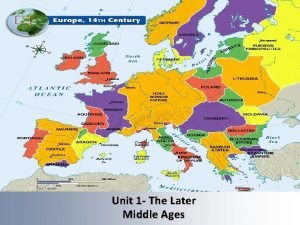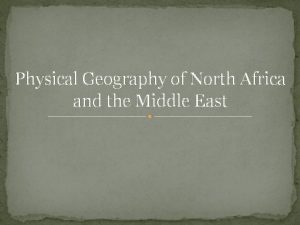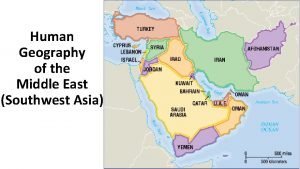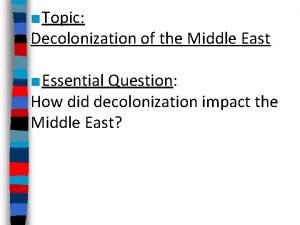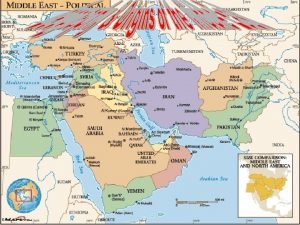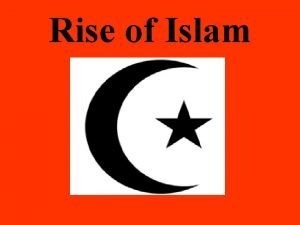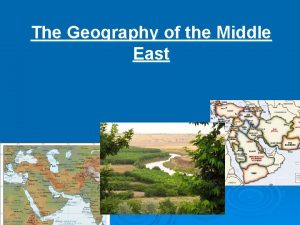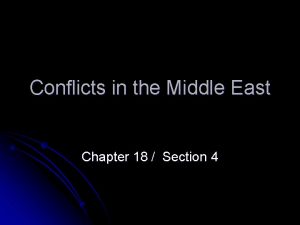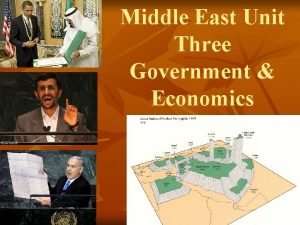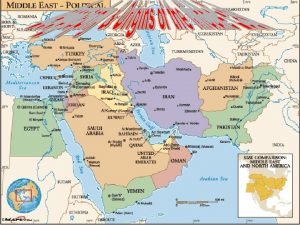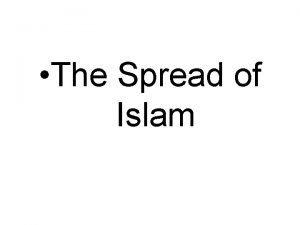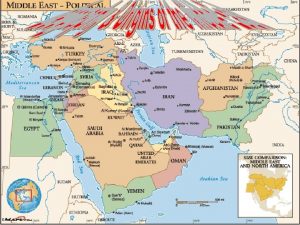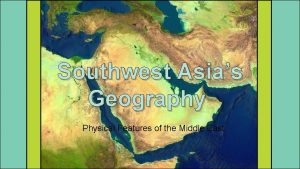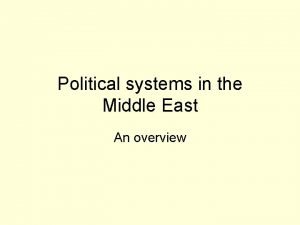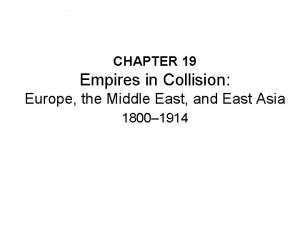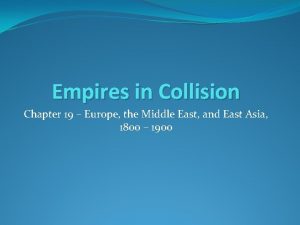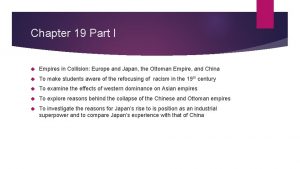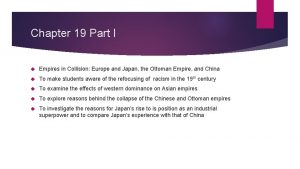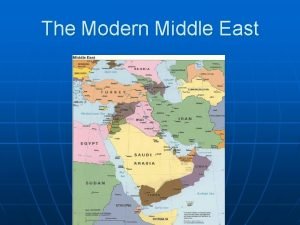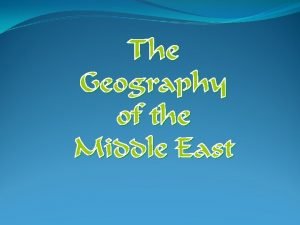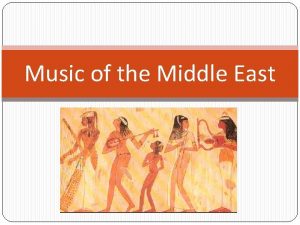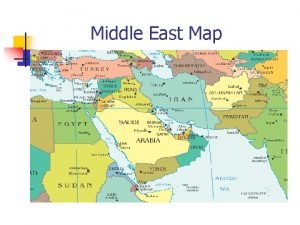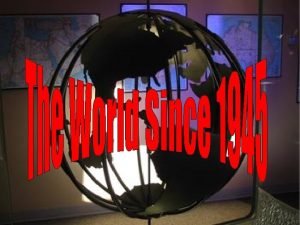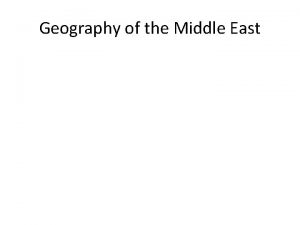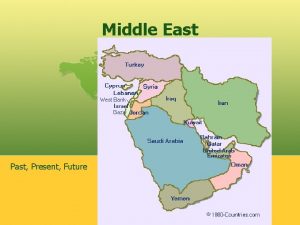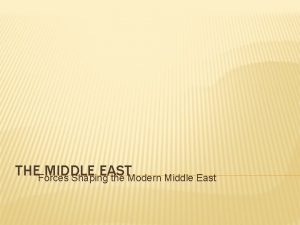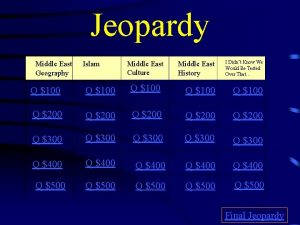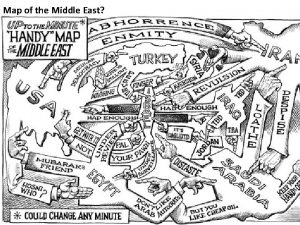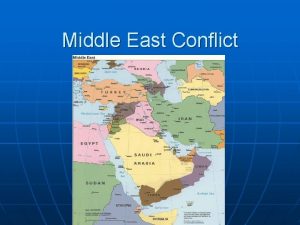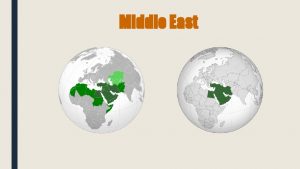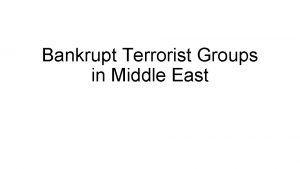Empires in Collision Europe the Middle East East


























- Slides: 26

Empires in Collision Europe, the Middle East, & East Asia 1800 -1900 Objective: Examine the effects of Western dominance on the empires of Asia

Reversal of Fortune: China’s Century of Crisis • China had continued the pattern of the previous several centuries, during which Chinese authorities had strictly controlled & limited the activities of European missionaries & merchants • By 1912, China’s long established imperial state had collapsed, & the country transformed from a central presence in the global economy to a weak & dependent participant in a Europeandominated world system

Crisis Within • China saw a drastic increase in their population but no Industrial Revolution accompanied this vast increase in population • Agriculture production wasn’t able to keep up the population increase • Pressure increased on small farmers while they faced unemployment, impoverishment, misery, & starvation • China’s government couldn’t manage the population increase & was unable to effectively perform its many functions • European military pressure & economic penetration also disrupted internal trade routes along with a variety of other things

Crisis Within • Taiping Uprising: massive Chinese rebellion against the ruling Qing dynasty that devastated much of the country between 1850 & 1864 • Hong Xiuquan claimed to be the younger brother of Jesus, sent to cleanse the world of demons • They called for the abolition of private property, a radical redistribution of land, the end of prostitution & opium smoking • They fought for women equality & the end to foot binding

Crisis Within • Division & indecisiveness within the Taiping leadership, along with their inability to link up with several other groups provided an opening for Qing dynasty loyalists to rally & crush the rebellion • This ultimately weakened the Chinese government • It took China more than a decade to recover from this rebellion/civil war

Western Pressures • The British found an enormous, growing, & very profitable market for the highly addictive drug Opium • Chinese authorities outlawed the drug but it was still smuggled into China • China found itself with million of addicts • A Chinese official Commissioner Lin Zexu led the campaign against opium use • Offended by the seizure of their property, the British sent a naval fleet to end the restrictive trade in China

Western Pressures • Opium Wars: Two wars fought between Western powers & China after China tried to restrict the importation of foreign goods • The Chinese defeat ended with unequal treaties that seriously eroded China’s independence by the end of the century • By the end of the century, the Western nations plus Japan & Russia had carved out spheres of influence within China • China became part of a European-based informal empire; an area dominated by Western powers but retaining its own government & measure of independence

The Failure of Conservative Modernization • Some Chinese used “self-strengthening” to reinvigorate a traditional China while borrowing cautiously from the West • They repaired irrigation while building industrial factories • However, this change was met by opposition from the conservative leaders • While the new industries remained dependent on foreigners • Boxer Rebellion: anti-foreign movement led by Chinese militia organizations, in which large numbers of Europeans & Chinese Christians were killed • When the rebellion was crushed, Western Powers imposed a huge payment on China as punishment

The Failure of Conservative Modernization • The Qing Dynasty was ineffective in protecting China • Chinese people began to admire Western science & technology but also Western political practices that limited the authority of the ruler & permitted wider circles of people to take part in public life • Chinese Revolution of 19111912: the collapse of China’s imperial order

The Ottoman Empire & the West in the Nineteenth Century • Islamic Civilization was a neighbor to Europe for 1000 years • The Ottoman Empire was a clear military & religious threat to Europe in the 16 th & 17 th century • China & the Ottoman empire didn’t fall under direct colonial rule but both were diminished as the changing balance of global power took hold

“The Sick Man of Europe” • In 1750, the Ottoman Empire was still the central political fixture of a widespread Islamic world • Its ruler, the Sultan, claimed the role of caliph, successor to the Prophet Muhammad • The Sultan was viewed as the leader, defender, & primary representative of the Islamic world • “The Sick Man of Europe”: Western Europe’s description of the Ottoman Empire in the 19 th century based on the empire’s economic & military weakness & its apparent inability to prevent the shrinking of its territory

“The Sick Man of Europe” • India, Indonesia, West Africa, Central Asia fell under the control of European Christian powers • Greece, Serbia, Bulgaria, & Romania achieved independence based on their own surging nationalism • The central Ottoman state had weakened in its ability to raise necessary revenue • Their land losses prevented them from direct oceanic accesses limiting their trading • Like China, the Ottoman Empire had fallen into a position of considerable dependency on Europe

Reform & Its Opponents • The leadership of the Ottoman Empire recognized many of its problems & during the nineteenth century mounted increasingly ambitious programs of “defensive modernization” • Sultan Selim III sought to reorganize & update the army • However, these changes were meet with opposition & Selim was overthrown & murdered • Tanzimat: the Ottoman leadership sough to provide the economic, social, & legal foundations for a strong & newly recentralized state • They began the process of modernization & westernization

Reform & Its Opponents • Although Tanzimat-era reforms did not directly address gender issues, they did stimulate modest educational openings for women • The Young Ottomans were actively seeking major changes in the Ottoman political system itself • They favored European-style parliamentary & constitutional regime • They felt they needed to overcome their backwardness to preserve the state against European aggression

Reform & Its Opponents • Sultan Abd al-Hamid II implemented a constitution & elected a parliament but soon suspended his reforms • Opposition to the government surfaced among both military & civilian elites known as the Young Turks • They abandoned any reference to Islam advocating for a militantly secular public life • A military coup in 1908 allowed the Young Turks to exercise real power & implemented drastic changes • The nationalist Turkish conception of Ottoman identity antagonized non-Turkic peoples & helped stimulate Arab & other nationalism in response

Outcomes: Comparing China & the Ottoman Empire • China & the Ottoman Empire were now informal colonies but retained their independence • Their governments launched campaigns to catch up with the West • China & the Ottoman Empire gave rise to new nationalist conceptions of society that were initially small but of greater significance for the future • China rejected traditional Confucian culture while modern Turkey rejected Islam • Islam however retained a hold on its civilization more firmly that Confucianism did in China

The Japanese Difference: The Rise of a New East Asian Power • Like China & the Ottoman Empire, the island country of Japan confronted the aggressive power of the West during the 19 th century • In the 2 nd half of the 19 th century, Japan undertook a radical transformation of its society • This radical transformation turned them into a powerful, modern, united, & industrialized nation • Japan joined the club of imperialist countries by creating its own East Asian empire at the expense of China & Korea

The Tokugawa Background • Japan had been governed by a shogun (a military ruler) from the Tokugawa family who acted in the name of the revered but powerless emperor • Their task was to prevent an rebellions & create internal peace • Feudal Lords known as daimyo kept most of their independence which prevented unity in Japan • Tokugawa Japan: a period of internal peace in Japan that prevented civil war but did not fully unify the country; led by military rulers who established a “closed door” policy towards the Europeans

The Tokugawa Background • Samurai in the absence of wars to fight, evolved into a salaried bureaucratic or administrative class • They remained loyal to their daimyo lords & to their warrior code of loyalty, honor, & selfsacrifice • The peace in Japan contributed to a remarkable burst of economic growth, commercialization, & urban development • Well-functioning networks of exchange linked urban & rural areas, marking Japan as an-emerging market economy • The influence of Confucianism encouraged education

The Tokugawa Background • These changes provided a solid foundation for Japan’s remarkable industrial growth in the late 19 th century • Merchants had money, but little status, while samurai enjoyed high status but were often indebted to inferior merchants • Despite prohibitions many peasants moved to the cities • Corruption was widespread & the shogunate’s failure to deal successfully with a severe famine in 1830 s eroded confidence in its effectiveness • A wave of local peasant uprising & urban riots expressed the many grievances of the poor

American Intrusion & the Meiji Restoration • Japan had deliberately limited its contact with the West to a single port, where only the Dutch were allowed to trade • Japan agreed to a series of unequal treaties with various Western powers • This humiliating surrender to the Western power triggered a civil war • Meiji Restoration: political take over of Japan by a group of young samurai to restore the young emperor, Meiji • They wanted to save Japan from foreign domination but also transform Japanese society to be more like Western Europe

Modernization Japanese-Style • The first task of the Meiji was to create national unity, which required an attack on the power & privileges of the daimyo & the samurai • The Meiji ended the semi-independent domains of the daimyo, replacing them with governors appointed by & responsible to the national government • The samurai relinquished their ancient roles as the country’s warrior class • The old Confucian-based social order with its special privileges for various classes was largely dismantled

Modernization Japanese-Style • In Japan there was also a widespread & eager fascination with almost everything Western • Civilization & Enlightenment was their slogan as a country • However, this initial wave of uncritical enthusiasm for everything Western receded • Japan proceeded to borrow more selectively & to combine foreign & Japanese elements in distinctive ways with Western ideas • For example, loyalty was still dedicated to the emperor • Their earlier experience in selective borrowing helped the Japanese adapt

Modernization Japanese-Style • Many argued that oppression of women was an obstacle to the country’s modernization & that family reform was essential to gaining the respect of the West • However, most male reformers understood women largely in the context of family life, seeing them as “good wife, wise mother” • At the core of Japan’s effort at defensive modernization lay its state-guided industrialization program • Taxed heavily to pay for Japan’s ambitious modernization program, many peasant families slid into poverty • Women were often exploited for women in textile industries

Japan & the World • Japan’s modern transformations soon registered internationally • Japan’s economic growth, openness to trade, & embrace of “civilization & enlightenment” from the West persuaded the Western powers to revise the unequal treaties in Japan’s favor • The Japanese launched its own empirebuilding enterprise • Russo-Japanese War: fought over rival ambitions in Korea & China, this conflict ended with Japanese victory • Japan became the first major Asian country to defeat a European country

Japan & the World • The Russian defeat shocked them & triggered the 1905 revolution in Russia • To Europeans & Americans, Japan was now an economic, political, & military competitor in Asia • The rise of Japan generated widespread admiration • However, those who directly experienced Japanese imperialism since their colonial practices matched or exceeded the brutality of European practices
 Difference between maritime and land based empires
Difference between maritime and land based empires North american
North american Early empires in the ancient near east
Early empires in the ancient near east European middle ages map
European middle ages map Why art has been an integral part in european history
Why art has been an integral part in european history What is the horizontal movement of air called
What is the horizontal movement of air called East is east and west is west
East is east and west is west North africa physical geography
North africa physical geography Middle east background
Middle east background Location of ukraine
Location of ukraine Southwest asia geography
Southwest asia geography Doing business 2012
Doing business 2012 Decolonization of middle east
Decolonization of middle east What three peninsulas are in the middle east
What three peninsulas are in the middle east Middle east before islam
Middle east before islam Why is it called middle east
Why is it called middle east Chapter 18 section 4 conflicts in the middle east
Chapter 18 section 4 conflicts in the middle east Middle east map
Middle east map Lesson 1 physical geography of south america
Lesson 1 physical geography of south america Gope
Gope Three peninsulas of the middle east
Three peninsulas of the middle east Middle east before islam
Middle east before islam Middle east war
Middle east war Three peninsulas
Three peninsulas Water pollution in the middle east
Water pollution in the middle east Physical features in the middle east
Physical features in the middle east Middle east political system
Middle east political system



